International HRM Strategy for TESCO's Entry into Russia
VerifiedAdded on 2019/09/16
|25
|5615
|589
Report
AI Summary
This report provides a comprehensive analysis of the human resource management (HRM) strategy for Tesco's potential entry into the Russian retail market. It begins with an executive summary, followed by an introduction outlining the importance of HRM in the context of globalization and international business. The report provides a company profile of Tesco and a profile of the suggested joint venture partner, Dixy. It then examines industry drivers in Russia, including political, economic, social, and technological factors, using a PESTLE analysis. The core of the report focuses on HRM policies, including recruitment and selection strategies, workforce planning, training and development, reward management, and performance management. The report recommends a polycentric approach to HRM, adapting practices to the local Russian context, and suggests a joint venture entry strategy. Finally, it concludes with recommendations for Tesco's HRM approach in Russia, including employee involvement strategies.

Contents
Executive Summary...............................................................................................................................2
Introduction...........................................................................................................................................3
Company Profile....................................................................................................................................5
Parent Company................................................................................................................................5
Host Company Profile.......................................................................................................................6
Industry Drivers in Russia.....................................................................................................................6
HRM Policies........................................................................................................................................8
Recruitment and Selection.....................................................................................................................8
Planning of workforce.......................................................................................................................9
Recruiting strategy................................................................................................................................9
Method of application and advertising.........................................................................................10
Sources of recruitment.........................................................................................................................11
Personal specifications........................................................................................................................12
Training and Development..................................................................................................................13
Identifying training needs....................................................................................................................14
Reward Management...........................................................................................................................15
Performance Management and Appraisal............................................................................................16
Employee Involvement........................................................................................................................19
Conclusion...........................................................................................................................................20
Recommendations...............................................................................................................................20
References...........................................................................................................................................22
1 | P a g e
Executive Summary...............................................................................................................................2
Introduction...........................................................................................................................................3
Company Profile....................................................................................................................................5
Parent Company................................................................................................................................5
Host Company Profile.......................................................................................................................6
Industry Drivers in Russia.....................................................................................................................6
HRM Policies........................................................................................................................................8
Recruitment and Selection.....................................................................................................................8
Planning of workforce.......................................................................................................................9
Recruiting strategy................................................................................................................................9
Method of application and advertising.........................................................................................10
Sources of recruitment.........................................................................................................................11
Personal specifications........................................................................................................................12
Training and Development..................................................................................................................13
Identifying training needs....................................................................................................................14
Reward Management...........................................................................................................................15
Performance Management and Appraisal............................................................................................16
Employee Involvement........................................................................................................................19
Conclusion...........................................................................................................................................20
Recommendations...............................................................................................................................20
References...........................................................................................................................................22
1 | P a g e
Paraphrase This Document
Need a fresh take? Get an instant paraphrase of this document with our AI Paraphraser
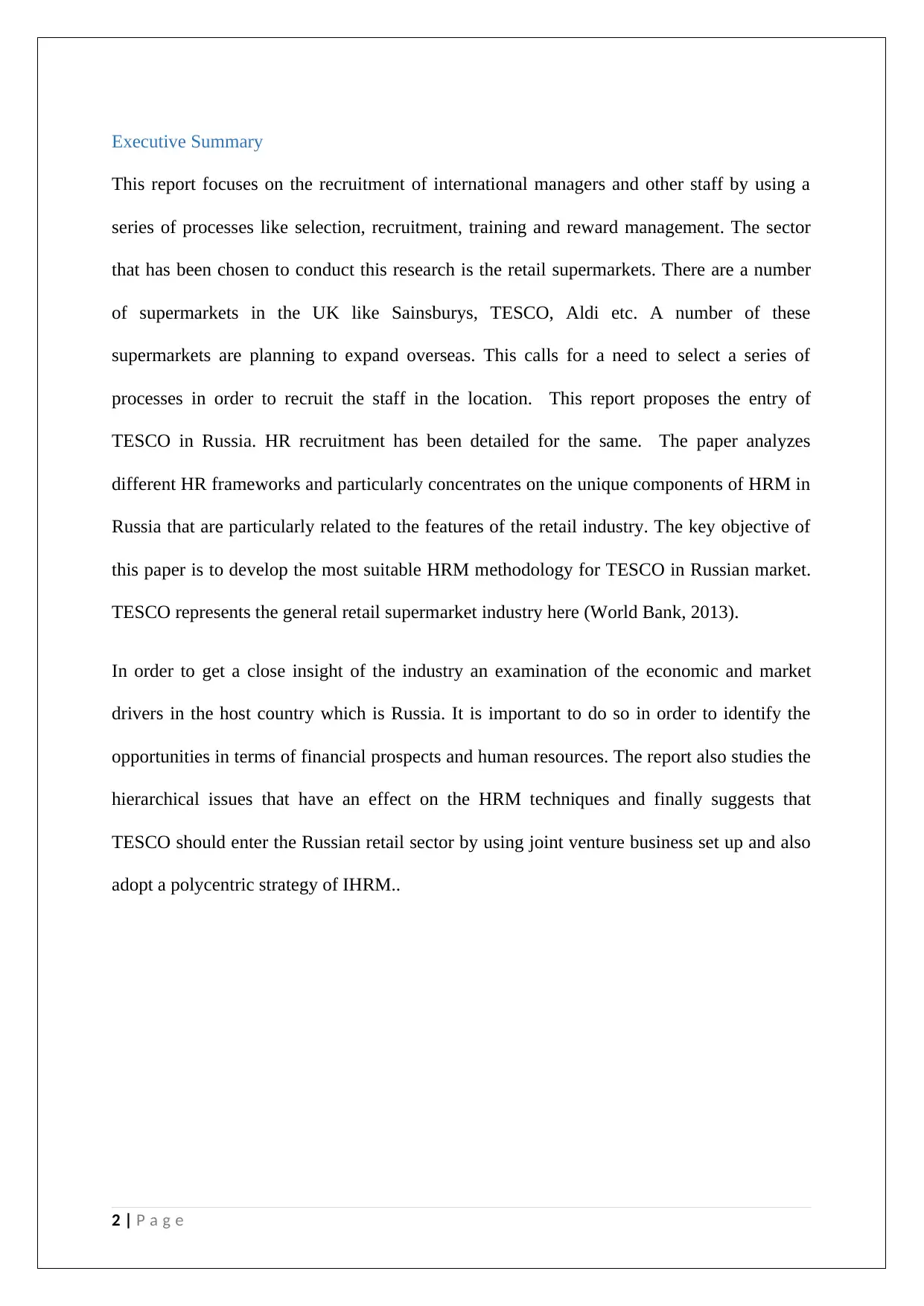
Executive Summary
This report focuses on the recruitment of international managers and other staff by using a
series of processes like selection, recruitment, training and reward management. The sector
that has been chosen to conduct this research is the retail supermarkets. There are a number
of supermarkets in the UK like Sainsburys, TESCO, Aldi etc. A number of these
supermarkets are planning to expand overseas. This calls for a need to select a series of
processes in order to recruit the staff in the location. This report proposes the entry of
TESCO in Russia. HR recruitment has been detailed for the same. The paper analyzes
different HR frameworks and particularly concentrates on the unique components of HRM in
Russia that are particularly related to the features of the retail industry. The key objective of
this paper is to develop the most suitable HRM methodology for TESCO in Russian market.
TESCO represents the general retail supermarket industry here (World Bank, 2013).
In order to get a close insight of the industry an examination of the economic and market
drivers in the host country which is Russia. It is important to do so in order to identify the
opportunities in terms of financial prospects and human resources. The report also studies the
hierarchical issues that have an effect on the HRM techniques and finally suggests that
TESCO should enter the Russian retail sector by using joint venture business set up and also
adopt a polycentric strategy of IHRM..
2 | P a g e
This report focuses on the recruitment of international managers and other staff by using a
series of processes like selection, recruitment, training and reward management. The sector
that has been chosen to conduct this research is the retail supermarkets. There are a number
of supermarkets in the UK like Sainsburys, TESCO, Aldi etc. A number of these
supermarkets are planning to expand overseas. This calls for a need to select a series of
processes in order to recruit the staff in the location. This report proposes the entry of
TESCO in Russia. HR recruitment has been detailed for the same. The paper analyzes
different HR frameworks and particularly concentrates on the unique components of HRM in
Russia that are particularly related to the features of the retail industry. The key objective of
this paper is to develop the most suitable HRM methodology for TESCO in Russian market.
TESCO represents the general retail supermarket industry here (World Bank, 2013).
In order to get a close insight of the industry an examination of the economic and market
drivers in the host country which is Russia. It is important to do so in order to identify the
opportunities in terms of financial prospects and human resources. The report also studies the
hierarchical issues that have an effect on the HRM techniques and finally suggests that
TESCO should enter the Russian retail sector by using joint venture business set up and also
adopt a polycentric strategy of IHRM..
2 | P a g e
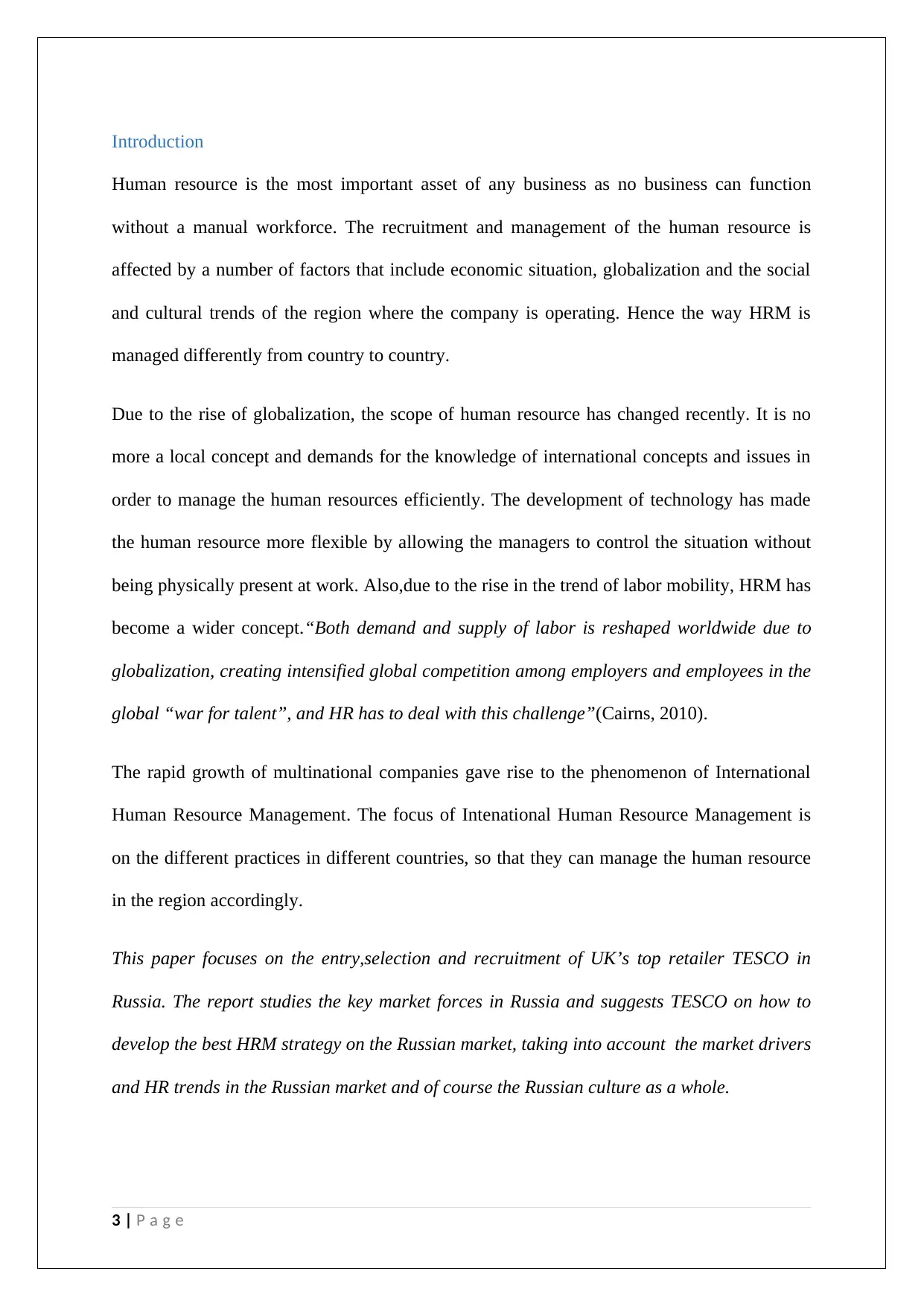
Introduction
Human resource is the most important asset of any business as no business can function
without a manual workforce. The recruitment and management of the human resource is
affected by a number of factors that include economic situation, globalization and the social
and cultural trends of the region where the company is operating. Hence the way HRM is
managed differently from country to country.
Due to the rise of globalization, the scope of human resource has changed recently. It is no
more a local concept and demands for the knowledge of international concepts and issues in
order to manage the human resources efficiently. The development of technology has made
the human resource more flexible by allowing the managers to control the situation without
being physically present at work. Also,due to the rise in the trend of labor mobility, HRM has
become a wider concept.“Both demand and supply of labor is reshaped worldwide due to
globalization, creating intensified global competition among employers and employees in the
global “war for talent”, and HR has to deal with this challenge”(Cairns, 2010).
The rapid growth of multinational companies gave rise to the phenomenon of International
Human Resource Management. The focus of Intenational Human Resource Management is
on the different practices in different countries, so that they can manage the human resource
in the region accordingly.
This paper focuses on the entry,selection and recruitment of UK’s top retailer TESCO in
Russia. The report studies the key market forces in Russia and suggests TESCO on how to
develop the best HRM strategy on the Russian market, taking into account the market drivers
and HR trends in the Russian market and of course the Russian culture as a whole.
3 | P a g e
Human resource is the most important asset of any business as no business can function
without a manual workforce. The recruitment and management of the human resource is
affected by a number of factors that include economic situation, globalization and the social
and cultural trends of the region where the company is operating. Hence the way HRM is
managed differently from country to country.
Due to the rise of globalization, the scope of human resource has changed recently. It is no
more a local concept and demands for the knowledge of international concepts and issues in
order to manage the human resources efficiently. The development of technology has made
the human resource more flexible by allowing the managers to control the situation without
being physically present at work. Also,due to the rise in the trend of labor mobility, HRM has
become a wider concept.“Both demand and supply of labor is reshaped worldwide due to
globalization, creating intensified global competition among employers and employees in the
global “war for talent”, and HR has to deal with this challenge”(Cairns, 2010).
The rapid growth of multinational companies gave rise to the phenomenon of International
Human Resource Management. The focus of Intenational Human Resource Management is
on the different practices in different countries, so that they can manage the human resource
in the region accordingly.
This paper focuses on the entry,selection and recruitment of UK’s top retailer TESCO in
Russia. The report studies the key market forces in Russia and suggests TESCO on how to
develop the best HRM strategy on the Russian market, taking into account the market drivers
and HR trends in the Russian market and of course the Russian culture as a whole.
3 | P a g e
⊘ This is a preview!⊘
Do you want full access?
Subscribe today to unlock all pages.

Trusted by 1+ million students worldwide
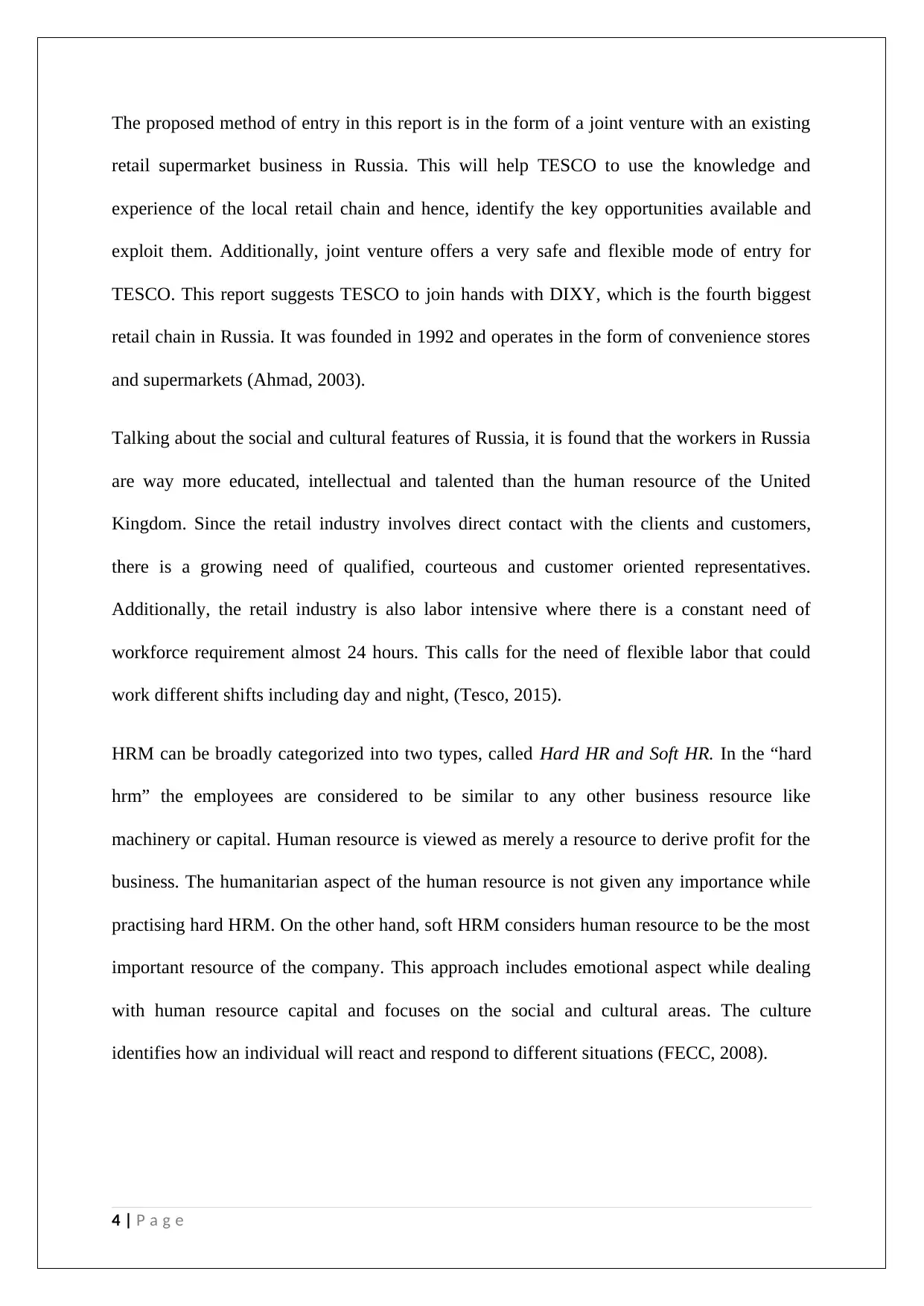
The proposed method of entry in this report is in the form of a joint venture with an existing
retail supermarket business in Russia. This will help TESCO to use the knowledge and
experience of the local retail chain and hence, identify the key opportunities available and
exploit them. Additionally, joint venture offers a very safe and flexible mode of entry for
TESCO. This report suggests TESCO to join hands with DIXY, which is the fourth biggest
retail chain in Russia. It was founded in 1992 and operates in the form of convenience stores
and supermarkets (Ahmad, 2003).
Talking about the social and cultural features of Russia, it is found that the workers in Russia
are way more educated, intellectual and talented than the human resource of the United
Kingdom. Since the retail industry involves direct contact with the clients and customers,
there is a growing need of qualified, courteous and customer oriented representatives.
Additionally, the retail industry is also labor intensive where there is a constant need of
workforce requirement almost 24 hours. This calls for the need of flexible labor that could
work different shifts including day and night, (Tesco, 2015).
HRM can be broadly categorized into two types, called Hard HR and Soft HR. In the “hard
hrm” the employees are considered to be similar to any other business resource like
machinery or capital. Human resource is viewed as merely a resource to derive profit for the
business. The humanitarian aspect of the human resource is not given any importance while
practising hard HRM. On the other hand, soft HRM considers human resource to be the most
important resource of the company. This approach includes emotional aspect while dealing
with human resource capital and focuses on the social and cultural areas. The culture
identifies how an individual will react and respond to different situations (FECC, 2008).
4 | P a g e
retail supermarket business in Russia. This will help TESCO to use the knowledge and
experience of the local retail chain and hence, identify the key opportunities available and
exploit them. Additionally, joint venture offers a very safe and flexible mode of entry for
TESCO. This report suggests TESCO to join hands with DIXY, which is the fourth biggest
retail chain in Russia. It was founded in 1992 and operates in the form of convenience stores
and supermarkets (Ahmad, 2003).
Talking about the social and cultural features of Russia, it is found that the workers in Russia
are way more educated, intellectual and talented than the human resource of the United
Kingdom. Since the retail industry involves direct contact with the clients and customers,
there is a growing need of qualified, courteous and customer oriented representatives.
Additionally, the retail industry is also labor intensive where there is a constant need of
workforce requirement almost 24 hours. This calls for the need of flexible labor that could
work different shifts including day and night, (Tesco, 2015).
HRM can be broadly categorized into two types, called Hard HR and Soft HR. In the “hard
hrm” the employees are considered to be similar to any other business resource like
machinery or capital. Human resource is viewed as merely a resource to derive profit for the
business. The humanitarian aspect of the human resource is not given any importance while
practising hard HRM. On the other hand, soft HRM considers human resource to be the most
important resource of the company. This approach includes emotional aspect while dealing
with human resource capital and focuses on the social and cultural areas. The culture
identifies how an individual will react and respond to different situations (FECC, 2008).
4 | P a g e
Paraphrase This Document
Need a fresh take? Get an instant paraphrase of this document with our AI Paraphraser
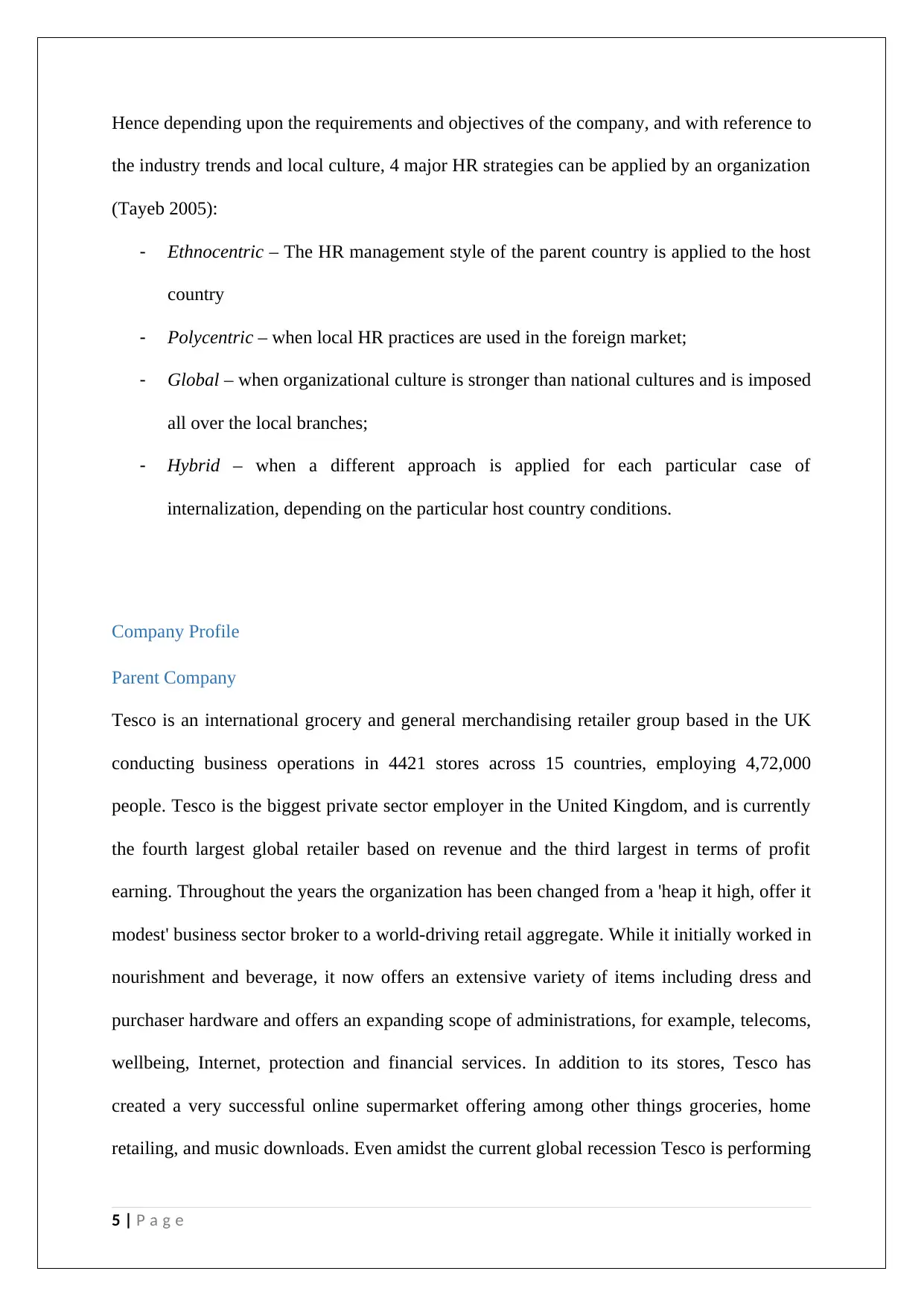
Hence depending upon the requirements and objectives of the company, and with reference to
the industry trends and local culture, 4 major HR strategies can be applied by an organization
(Tayeb 2005):
- Ethnocentric – The HR management style of the parent country is applied to the host
country
- Polycentric – when local HR practices are used in the foreign market;
- Global – when organizational culture is stronger than national cultures and is imposed
all over the local branches;
- Hybrid – when a different approach is applied for each particular case of
internalization, depending on the particular host country conditions.
Company Profile
Parent Company
Tesco is an international grocery and general merchandising retailer group based in the UK
conducting business operations in 4421 stores across 15 countries, employing 4,72,000
people. Tesco is the biggest private sector employer in the United Kingdom, and is currently
the fourth largest global retailer based on revenue and the third largest in terms of profit
earning. Throughout the years the organization has been changed from a 'heap it high, offer it
modest' business sector broker to a world-driving retail aggregate. While it initially worked in
nourishment and beverage, it now offers an extensive variety of items including dress and
purchaser hardware and offers an expanding scope of administrations, for example, telecoms,
wellbeing, Internet, protection and financial services. In addition to its stores, Tesco has
created a very successful online supermarket offering among other things groceries, home
retailing, and music downloads. Even amidst the current global recession Tesco is performing
5 | P a g e
the industry trends and local culture, 4 major HR strategies can be applied by an organization
(Tayeb 2005):
- Ethnocentric – The HR management style of the parent country is applied to the host
country
- Polycentric – when local HR practices are used in the foreign market;
- Global – when organizational culture is stronger than national cultures and is imposed
all over the local branches;
- Hybrid – when a different approach is applied for each particular case of
internalization, depending on the particular host country conditions.
Company Profile
Parent Company
Tesco is an international grocery and general merchandising retailer group based in the UK
conducting business operations in 4421 stores across 15 countries, employing 4,72,000
people. Tesco is the biggest private sector employer in the United Kingdom, and is currently
the fourth largest global retailer based on revenue and the third largest in terms of profit
earning. Throughout the years the organization has been changed from a 'heap it high, offer it
modest' business sector broker to a world-driving retail aggregate. While it initially worked in
nourishment and beverage, it now offers an extensive variety of items including dress and
purchaser hardware and offers an expanding scope of administrations, for example, telecoms,
wellbeing, Internet, protection and financial services. In addition to its stores, Tesco has
created a very successful online supermarket offering among other things groceries, home
retailing, and music downloads. Even amidst the current global recession Tesco is performing
5 | P a g e
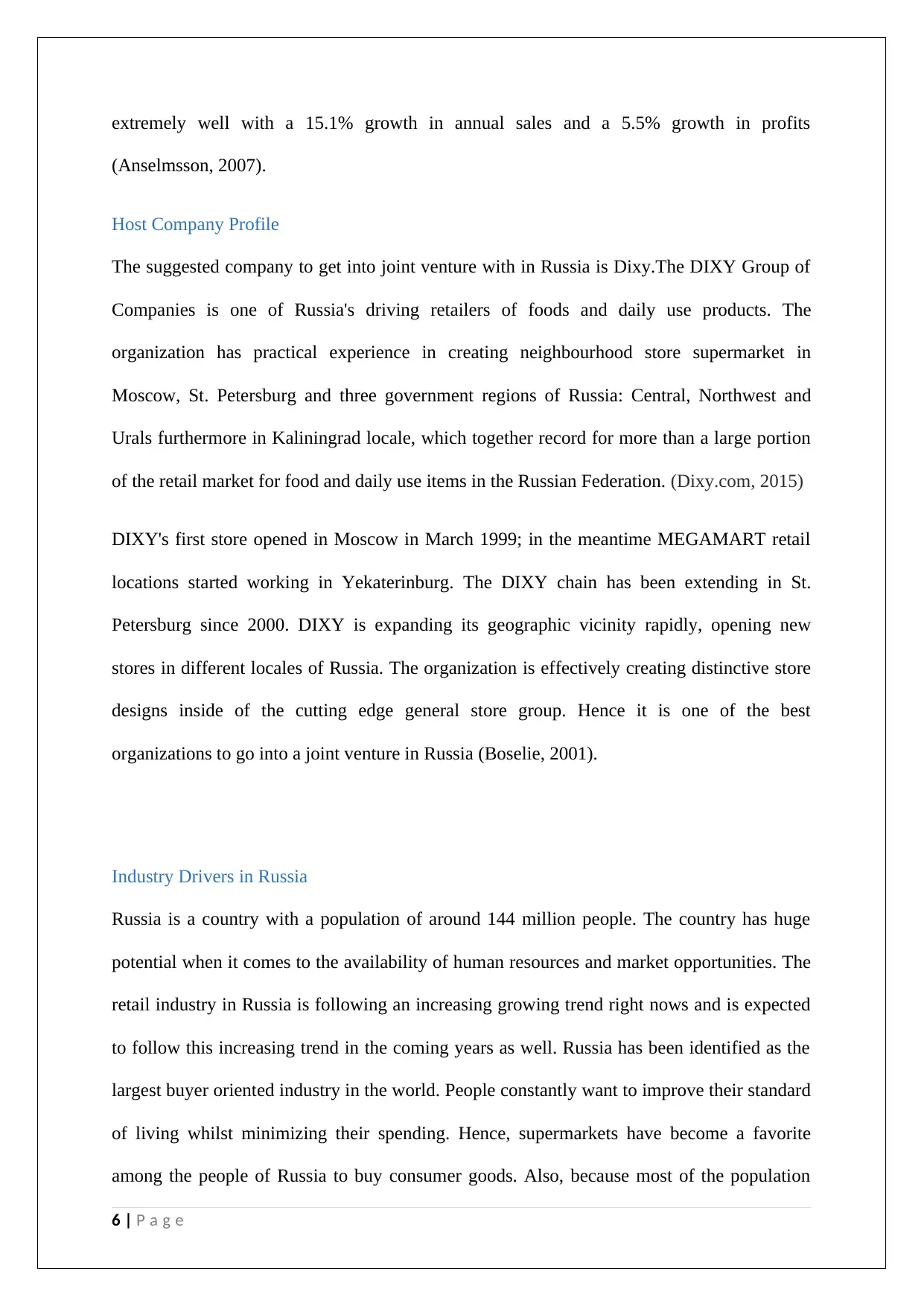
extremely well with a 15.1% growth in annual sales and a 5.5% growth in profits
(Anselmsson, 2007).
Host Company Profile
The suggested company to get into joint venture with in Russia is Dixy.The DIXY Group of
Companies is one of Russia's driving retailers of foods and daily use products. The
organization has practical experience in creating neighbourhood store supermarket in
Moscow, St. Petersburg and three government regions of Russia: Central, Northwest and
Urals furthermore in Kaliningrad locale, which together record for more than a large portion
of the retail market for food and daily use items in the Russian Federation. (Dixy.com, 2015)
DIXY's first store opened in Moscow in March 1999; in the meantime MEGAMART retail
locations started working in Yekaterinburg. The DIXY chain has been extending in St.
Petersburg since 2000. DIXY is expanding its geographic vicinity rapidly, opening new
stores in different locales of Russia. The organization is effectively creating distinctive store
designs inside of the cutting edge general store group. Hence it is one of the best
organizations to go into a joint venture in Russia (Boselie, 2001).
Industry Drivers in Russia
Russia is a country with a population of around 144 million people. The country has huge
potential when it comes to the availability of human resources and market opportunities. The
retail industry in Russia is following an increasing growing trend right nows and is expected
to follow this increasing trend in the coming years as well. Russia has been identified as the
largest buyer oriented industry in the world. People constantly want to improve their standard
of living whilst minimizing their spending. Hence, supermarkets have become a favorite
among the people of Russia to buy consumer goods. Also, because most of the population
6 | P a g e
(Anselmsson, 2007).
Host Company Profile
The suggested company to get into joint venture with in Russia is Dixy.The DIXY Group of
Companies is one of Russia's driving retailers of foods and daily use products. The
organization has practical experience in creating neighbourhood store supermarket in
Moscow, St. Petersburg and three government regions of Russia: Central, Northwest and
Urals furthermore in Kaliningrad locale, which together record for more than a large portion
of the retail market for food and daily use items in the Russian Federation. (Dixy.com, 2015)
DIXY's first store opened in Moscow in March 1999; in the meantime MEGAMART retail
locations started working in Yekaterinburg. The DIXY chain has been extending in St.
Petersburg since 2000. DIXY is expanding its geographic vicinity rapidly, opening new
stores in different locales of Russia. The organization is effectively creating distinctive store
designs inside of the cutting edge general store group. Hence it is one of the best
organizations to go into a joint venture in Russia (Boselie, 2001).
Industry Drivers in Russia
Russia is a country with a population of around 144 million people. The country has huge
potential when it comes to the availability of human resources and market opportunities. The
retail industry in Russia is following an increasing growing trend right nows and is expected
to follow this increasing trend in the coming years as well. Russia has been identified as the
largest buyer oriented industry in the world. People constantly want to improve their standard
of living whilst minimizing their spending. Hence, supermarkets have become a favorite
among the people of Russia to buy consumer goods. Also, because most of the population
6 | P a g e
⊘ This is a preview!⊘
Do you want full access?
Subscribe today to unlock all pages.

Trusted by 1+ million students worldwide
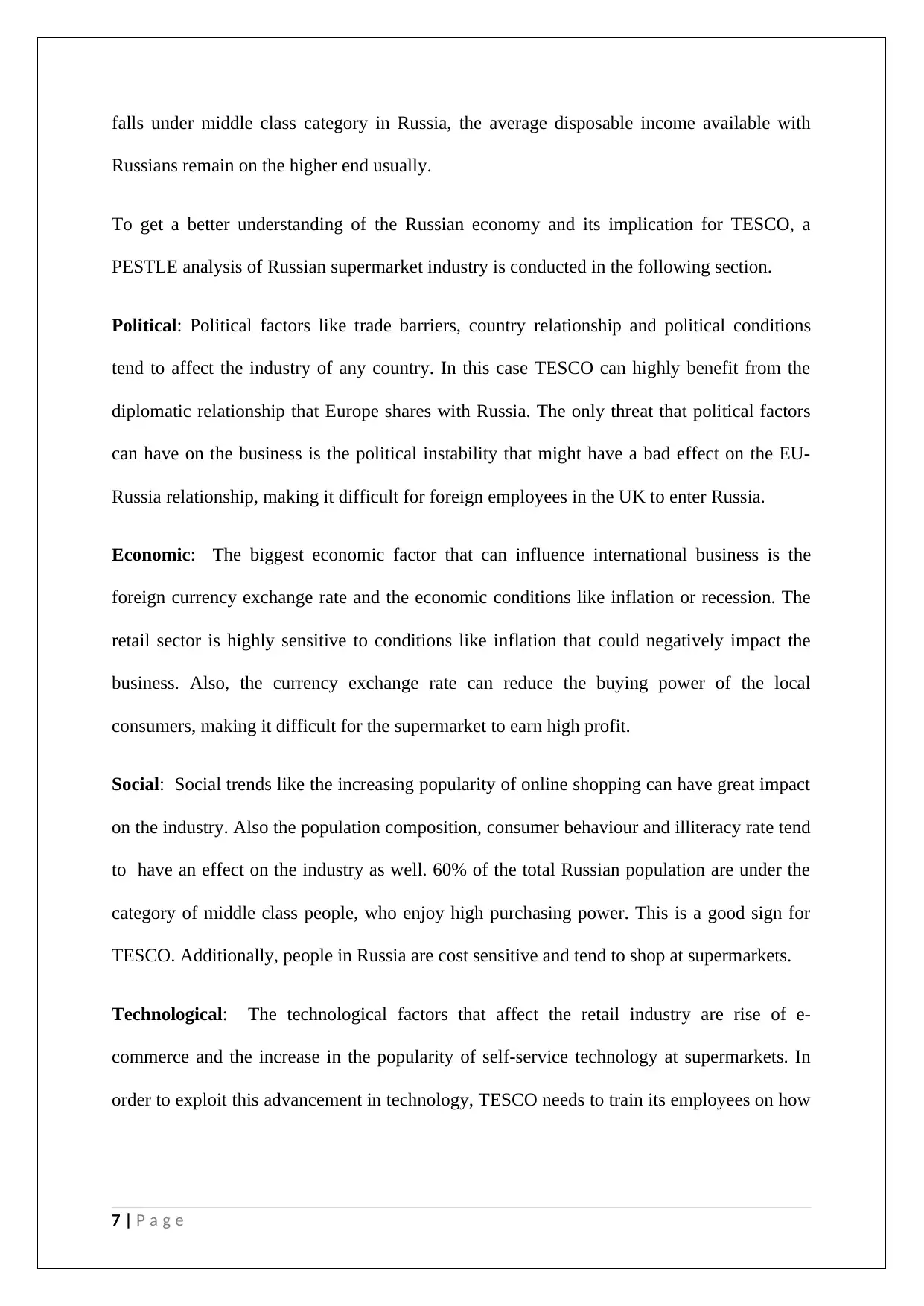
falls under middle class category in Russia, the average disposable income available with
Russians remain on the higher end usually.
To get a better understanding of the Russian economy and its implication for TESCO, a
PESTLE analysis of Russian supermarket industry is conducted in the following section.
Political: Political factors like trade barriers, country relationship and political conditions
tend to affect the industry of any country. In this case TESCO can highly benefit from the
diplomatic relationship that Europe shares with Russia. The only threat that political factors
can have on the business is the political instability that might have a bad effect on the EU-
Russia relationship, making it difficult for foreign employees in the UK to enter Russia.
Economic: The biggest economic factor that can influence international business is the
foreign currency exchange rate and the economic conditions like inflation or recession. The
retail sector is highly sensitive to conditions like inflation that could negatively impact the
business. Also, the currency exchange rate can reduce the buying power of the local
consumers, making it difficult for the supermarket to earn high profit.
Social: Social trends like the increasing popularity of online shopping can have great impact
on the industry. Also the population composition, consumer behaviour and illiteracy rate tend
to have an effect on the industry as well. 60% of the total Russian population are under the
category of middle class people, who enjoy high purchasing power. This is a good sign for
TESCO. Additionally, people in Russia are cost sensitive and tend to shop at supermarkets.
Technological: The technological factors that affect the retail industry are rise of e-
commerce and the increase in the popularity of self-service technology at supermarkets. In
order to exploit this advancement in technology, TESCO needs to train its employees on how
7 | P a g e
Russians remain on the higher end usually.
To get a better understanding of the Russian economy and its implication for TESCO, a
PESTLE analysis of Russian supermarket industry is conducted in the following section.
Political: Political factors like trade barriers, country relationship and political conditions
tend to affect the industry of any country. In this case TESCO can highly benefit from the
diplomatic relationship that Europe shares with Russia. The only threat that political factors
can have on the business is the political instability that might have a bad effect on the EU-
Russia relationship, making it difficult for foreign employees in the UK to enter Russia.
Economic: The biggest economic factor that can influence international business is the
foreign currency exchange rate and the economic conditions like inflation or recession. The
retail sector is highly sensitive to conditions like inflation that could negatively impact the
business. Also, the currency exchange rate can reduce the buying power of the local
consumers, making it difficult for the supermarket to earn high profit.
Social: Social trends like the increasing popularity of online shopping can have great impact
on the industry. Also the population composition, consumer behaviour and illiteracy rate tend
to have an effect on the industry as well. 60% of the total Russian population are under the
category of middle class people, who enjoy high purchasing power. This is a good sign for
TESCO. Additionally, people in Russia are cost sensitive and tend to shop at supermarkets.
Technological: The technological factors that affect the retail industry are rise of e-
commerce and the increase in the popularity of self-service technology at supermarkets. In
order to exploit this advancement in technology, TESCO needs to train its employees on how
7 | P a g e
Paraphrase This Document
Need a fresh take? Get an instant paraphrase of this document with our AI Paraphraser
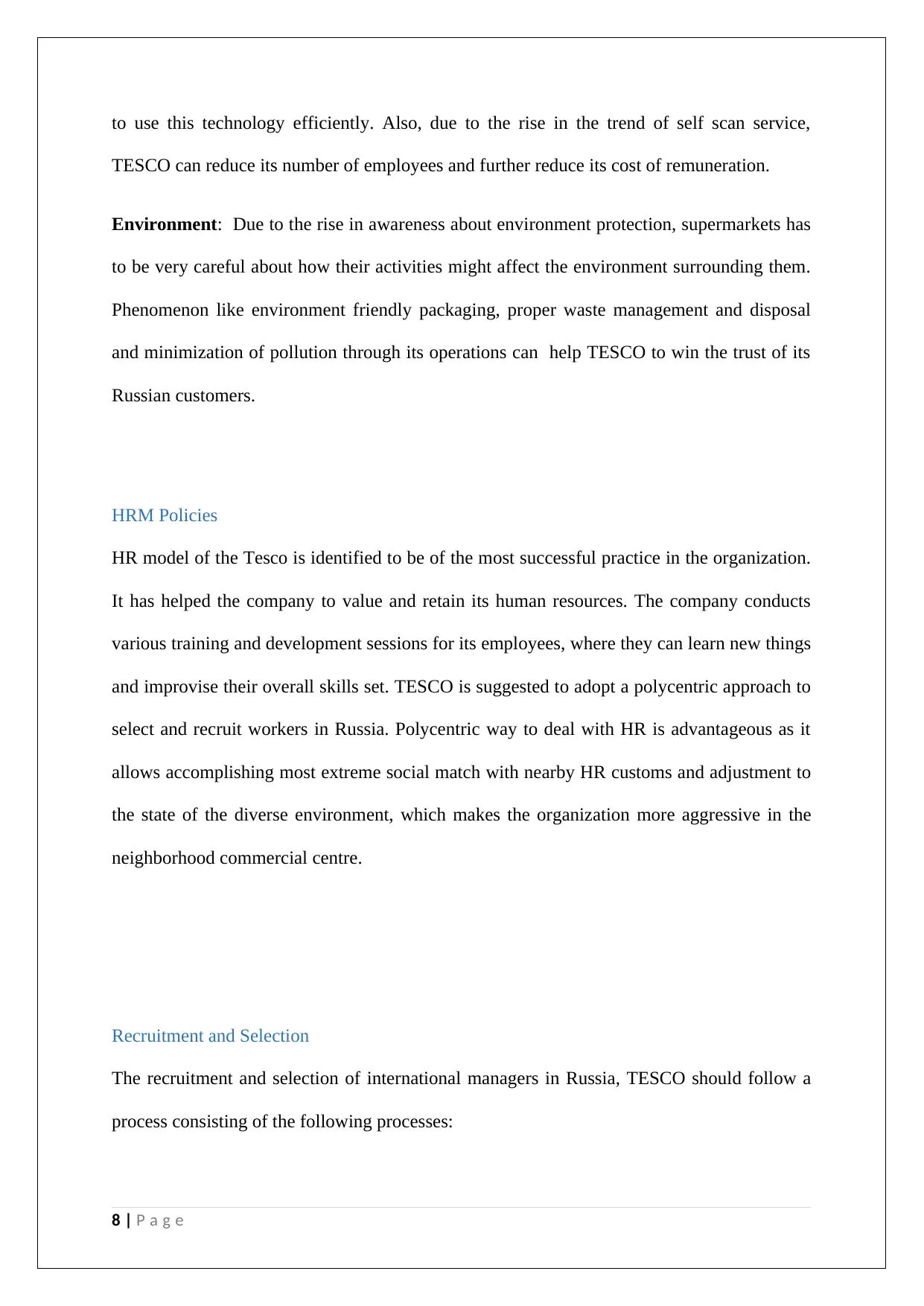
to use this technology efficiently. Also, due to the rise in the trend of self scan service,
TESCO can reduce its number of employees and further reduce its cost of remuneration.
Environment: Due to the rise in awareness about environment protection, supermarkets has
to be very careful about how their activities might affect the environment surrounding them.
Phenomenon like environment friendly packaging, proper waste management and disposal
and minimization of pollution through its operations can help TESCO to win the trust of its
Russian customers.
HRM Policies
HR model of the Tesco is identified to be of the most successful practice in the organization.
It has helped the company to value and retain its human resources. The company conducts
various training and development sessions for its employees, where they can learn new things
and improvise their overall skills set. TESCO is suggested to adopt a polycentric approach to
select and recruit workers in Russia. Polycentric way to deal with HR is advantageous as it
allows accomplishing most extreme social match with nearby HR customs and adjustment to
the state of the diverse environment, which makes the organization more aggressive in the
neighborhood commercial centre.
Recruitment and Selection
The recruitment and selection of international managers in Russia, TESCO should follow a
process consisting of the following processes:
8 | P a g e
TESCO can reduce its number of employees and further reduce its cost of remuneration.
Environment: Due to the rise in awareness about environment protection, supermarkets has
to be very careful about how their activities might affect the environment surrounding them.
Phenomenon like environment friendly packaging, proper waste management and disposal
and minimization of pollution through its operations can help TESCO to win the trust of its
Russian customers.
HRM Policies
HR model of the Tesco is identified to be of the most successful practice in the organization.
It has helped the company to value and retain its human resources. The company conducts
various training and development sessions for its employees, where they can learn new things
and improvise their overall skills set. TESCO is suggested to adopt a polycentric approach to
select and recruit workers in Russia. Polycentric way to deal with HR is advantageous as it
allows accomplishing most extreme social match with nearby HR customs and adjustment to
the state of the diverse environment, which makes the organization more aggressive in the
neighborhood commercial centre.
Recruitment and Selection
The recruitment and selection of international managers in Russia, TESCO should follow a
process consisting of the following processes:
8 | P a g e
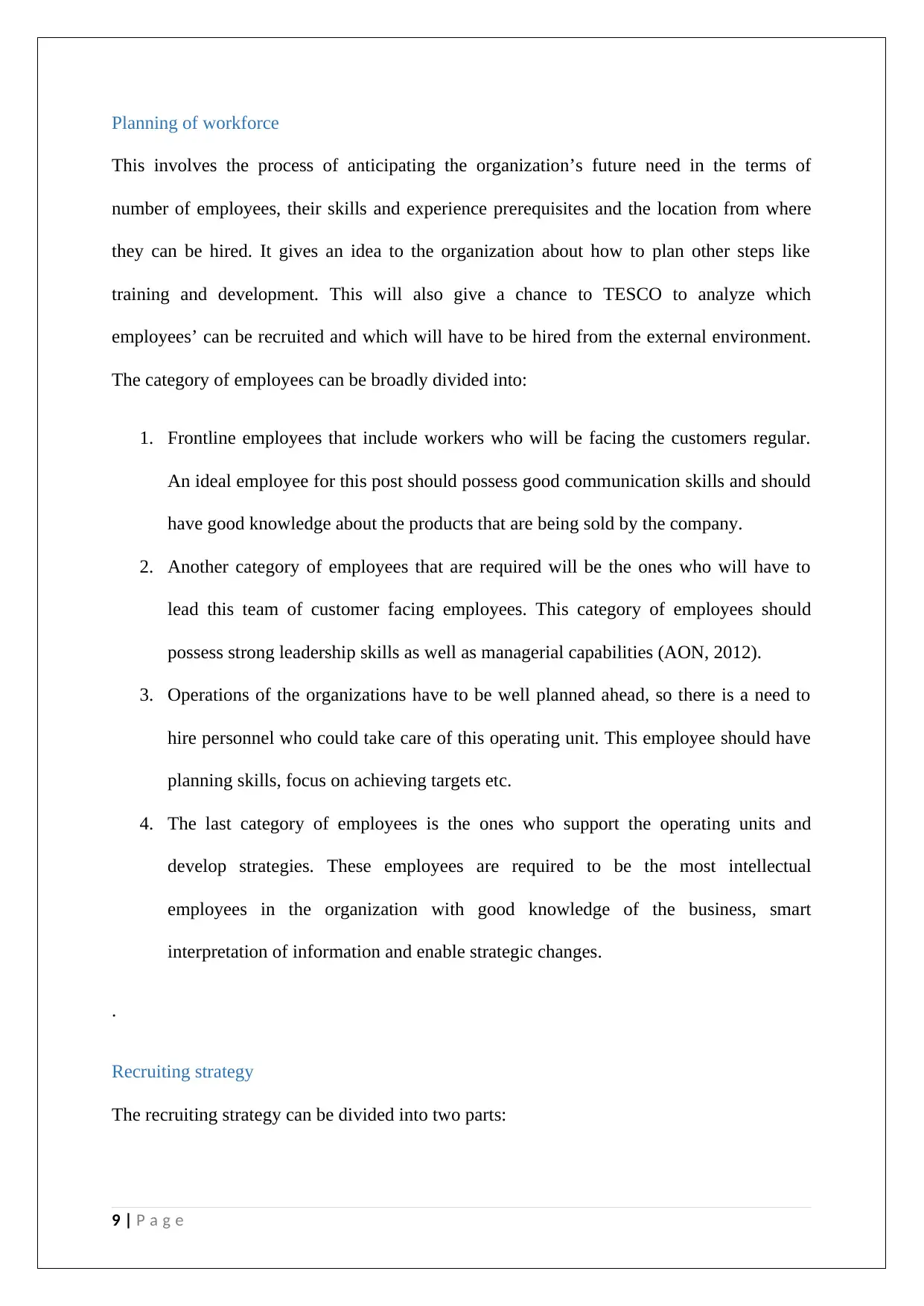
Planning of workforce
This involves the process of anticipating the organization’s future need in the terms of
number of employees, their skills and experience prerequisites and the location from where
they can be hired. It gives an idea to the organization about how to plan other steps like
training and development. This will also give a chance to TESCO to analyze which
employees’ can be recruited and which will have to be hired from the external environment.
The category of employees can be broadly divided into:
1. Frontline employees that include workers who will be facing the customers regular.
An ideal employee for this post should possess good communication skills and should
have good knowledge about the products that are being sold by the company.
2. Another category of employees that are required will be the ones who will have to
lead this team of customer facing employees. This category of employees should
possess strong leadership skills as well as managerial capabilities (AON, 2012).
3. Operations of the organizations have to be well planned ahead, so there is a need to
hire personnel who could take care of this operating unit. This employee should have
planning skills, focus on achieving targets etc.
4. The last category of employees is the ones who support the operating units and
develop strategies. These employees are required to be the most intellectual
employees in the organization with good knowledge of the business, smart
interpretation of information and enable strategic changes.
.
Recruiting strategy
The recruiting strategy can be divided into two parts:
9 | P a g e
This involves the process of anticipating the organization’s future need in the terms of
number of employees, their skills and experience prerequisites and the location from where
they can be hired. It gives an idea to the organization about how to plan other steps like
training and development. This will also give a chance to TESCO to analyze which
employees’ can be recruited and which will have to be hired from the external environment.
The category of employees can be broadly divided into:
1. Frontline employees that include workers who will be facing the customers regular.
An ideal employee for this post should possess good communication skills and should
have good knowledge about the products that are being sold by the company.
2. Another category of employees that are required will be the ones who will have to
lead this team of customer facing employees. This category of employees should
possess strong leadership skills as well as managerial capabilities (AON, 2012).
3. Operations of the organizations have to be well planned ahead, so there is a need to
hire personnel who could take care of this operating unit. This employee should have
planning skills, focus on achieving targets etc.
4. The last category of employees is the ones who support the operating units and
develop strategies. These employees are required to be the most intellectual
employees in the organization with good knowledge of the business, smart
interpretation of information and enable strategic changes.
.
Recruiting strategy
The recruiting strategy can be divided into two parts:
9 | P a g e
⊘ This is a preview!⊘
Do you want full access?
Subscribe today to unlock all pages.

Trusted by 1+ million students worldwide
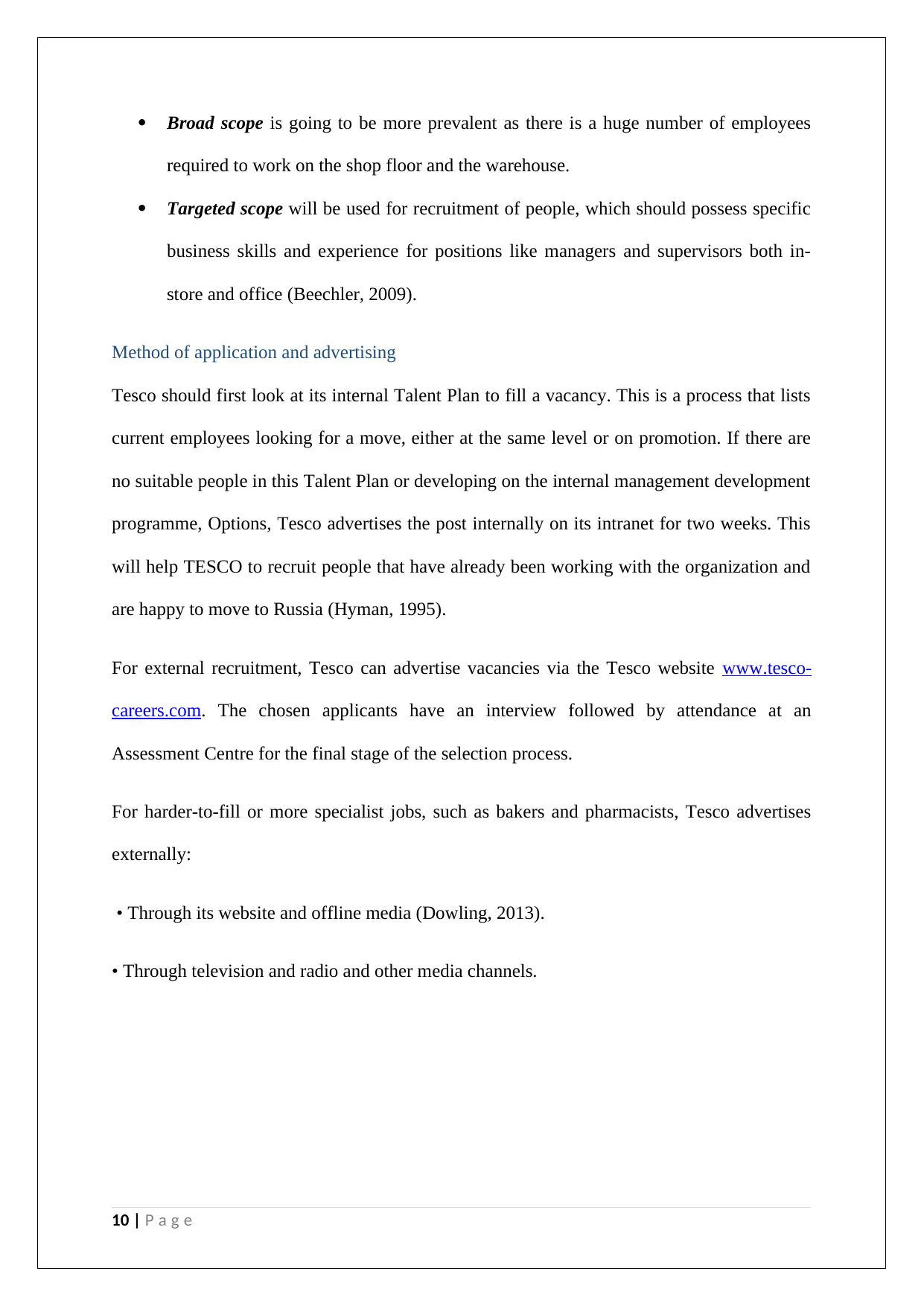
Broad scope is going to be more prevalent as there is a huge number of employees
required to work on the shop floor and the warehouse.
Targeted scope will be used for recruitment of people, which should possess specific
business skills and experience for positions like managers and supervisors both in-
store and office (Beechler, 2009).
Method of application and advertising
Tesco should first look at its internal Talent Plan to fill a vacancy. This is a process that lists
current employees looking for a move, either at the same level or on promotion. If there are
no suitable people in this Talent Plan or developing on the internal management development
programme, Options, Tesco advertises the post internally on its intranet for two weeks. This
will help TESCO to recruit people that have already been working with the organization and
are happy to move to Russia (Hyman, 1995).
For external recruitment, Tesco can advertise vacancies via the Tesco website www.tesco-
careers.com. The chosen applicants have an interview followed by attendance at an
Assessment Centre for the final stage of the selection process.
For harder-to-fill or more specialist jobs, such as bakers and pharmacists, Tesco advertises
externally:
• Through its website and offline media (Dowling, 2013).
• Through television and radio and other media channels.
10 | P a g e
required to work on the shop floor and the warehouse.
Targeted scope will be used for recruitment of people, which should possess specific
business skills and experience for positions like managers and supervisors both in-
store and office (Beechler, 2009).
Method of application and advertising
Tesco should first look at its internal Talent Plan to fill a vacancy. This is a process that lists
current employees looking for a move, either at the same level or on promotion. If there are
no suitable people in this Talent Plan or developing on the internal management development
programme, Options, Tesco advertises the post internally on its intranet for two weeks. This
will help TESCO to recruit people that have already been working with the organization and
are happy to move to Russia (Hyman, 1995).
For external recruitment, Tesco can advertise vacancies via the Tesco website www.tesco-
careers.com. The chosen applicants have an interview followed by attendance at an
Assessment Centre for the final stage of the selection process.
For harder-to-fill or more specialist jobs, such as bakers and pharmacists, Tesco advertises
externally:
• Through its website and offline media (Dowling, 2013).
• Through television and radio and other media channels.
10 | P a g e
Paraphrase This Document
Need a fresh take? Get an instant paraphrase of this document with our AI Paraphraser
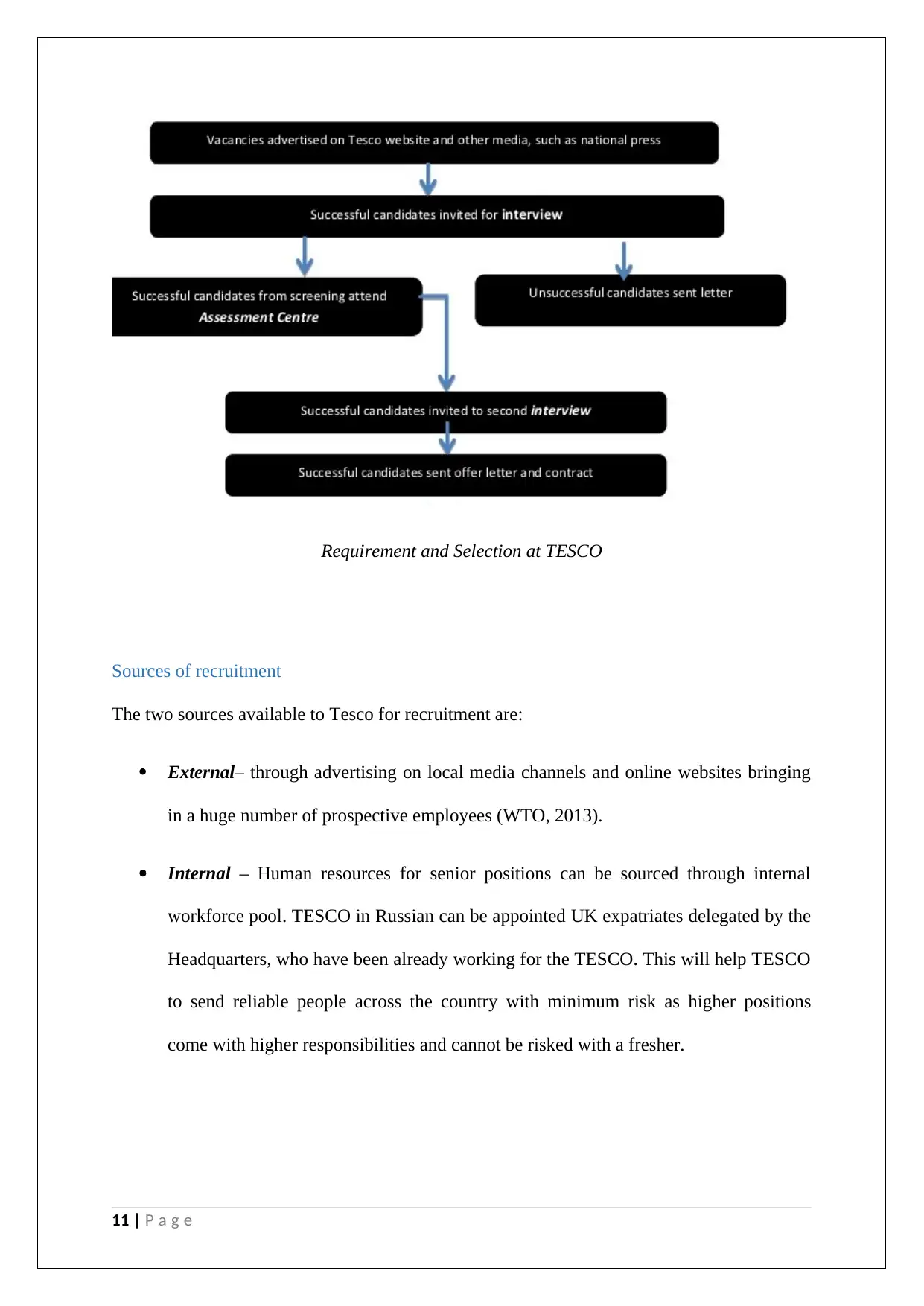
Requirement and Selection at TESCO
Sources of recruitment
The two sources available to Tesco for recruitment are:
External– through advertising on local media channels and online websites bringing
in a huge number of prospective employees (WTO, 2013).
Internal – Human resources for senior positions can be sourced through internal
workforce pool. TESCO in Russian can be appointed UK expatriates delegated by the
Headquarters, who have been already working for the TESCO. This will help TESCO
to send reliable people across the country with minimum risk as higher positions
come with higher responsibilities and cannot be risked with a fresher.
11 | P a g e
Sources of recruitment
The two sources available to Tesco for recruitment are:
External– through advertising on local media channels and online websites bringing
in a huge number of prospective employees (WTO, 2013).
Internal – Human resources for senior positions can be sourced through internal
workforce pool. TESCO in Russian can be appointed UK expatriates delegated by the
Headquarters, who have been already working for the TESCO. This will help TESCO
to send reliable people across the country with minimum risk as higher positions
come with higher responsibilities and cannot be risked with a fresher.
11 | P a g e
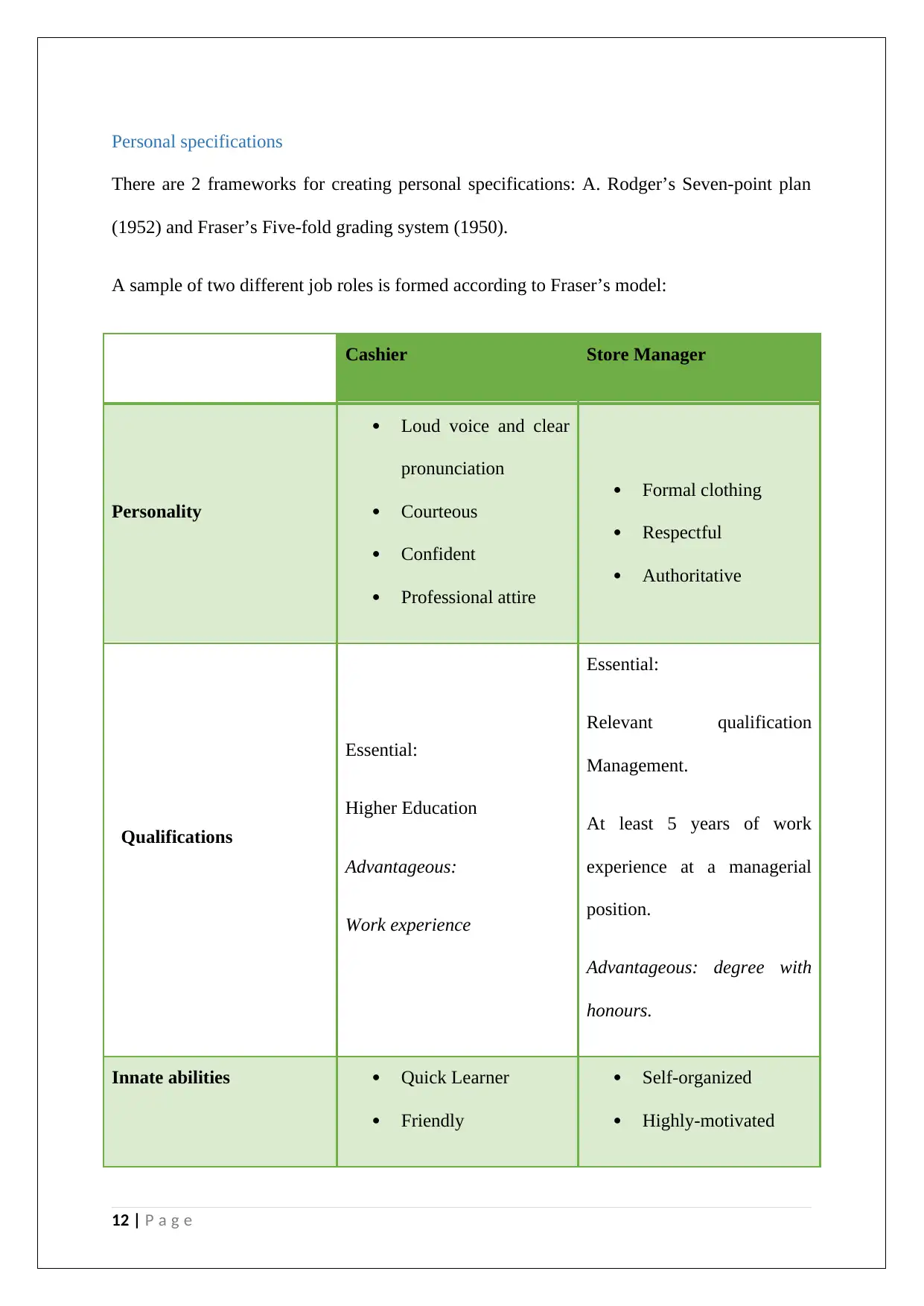
Personal specifications
There are 2 frameworks for creating personal specifications: A. Rodger’s Seven-point plan
(1952) and Fraser’s Five-fold grading system (1950).
A sample of two different job roles is formed according to Fraser’s model:
Cashier Store Manager
Personality
Loud voice and clear
pronunciation
Courteous
Confident
Professional attire
Formal clothing
Respectful
Authoritative
Qualifications
Essential:
Higher Education
Advantageous:
Work experience
Essential:
Relevant qualification
Management.
At least 5 years of work
experience at a managerial
position.
Advantageous: degree with
honours.
Innate abilities Quick Learner
Friendly
Self-organized
Highly-motivated
12 | P a g e
There are 2 frameworks for creating personal specifications: A. Rodger’s Seven-point plan
(1952) and Fraser’s Five-fold grading system (1950).
A sample of two different job roles is formed according to Fraser’s model:
Cashier Store Manager
Personality
Loud voice and clear
pronunciation
Courteous
Confident
Professional attire
Formal clothing
Respectful
Authoritative
Qualifications
Essential:
Higher Education
Advantageous:
Work experience
Essential:
Relevant qualification
Management.
At least 5 years of work
experience at a managerial
position.
Advantageous: degree with
honours.
Innate abilities Quick Learner
Friendly
Self-organized
Highly-motivated
12 | P a g e
⊘ This is a preview!⊘
Do you want full access?
Subscribe today to unlock all pages.

Trusted by 1+ million students worldwide
1 out of 25